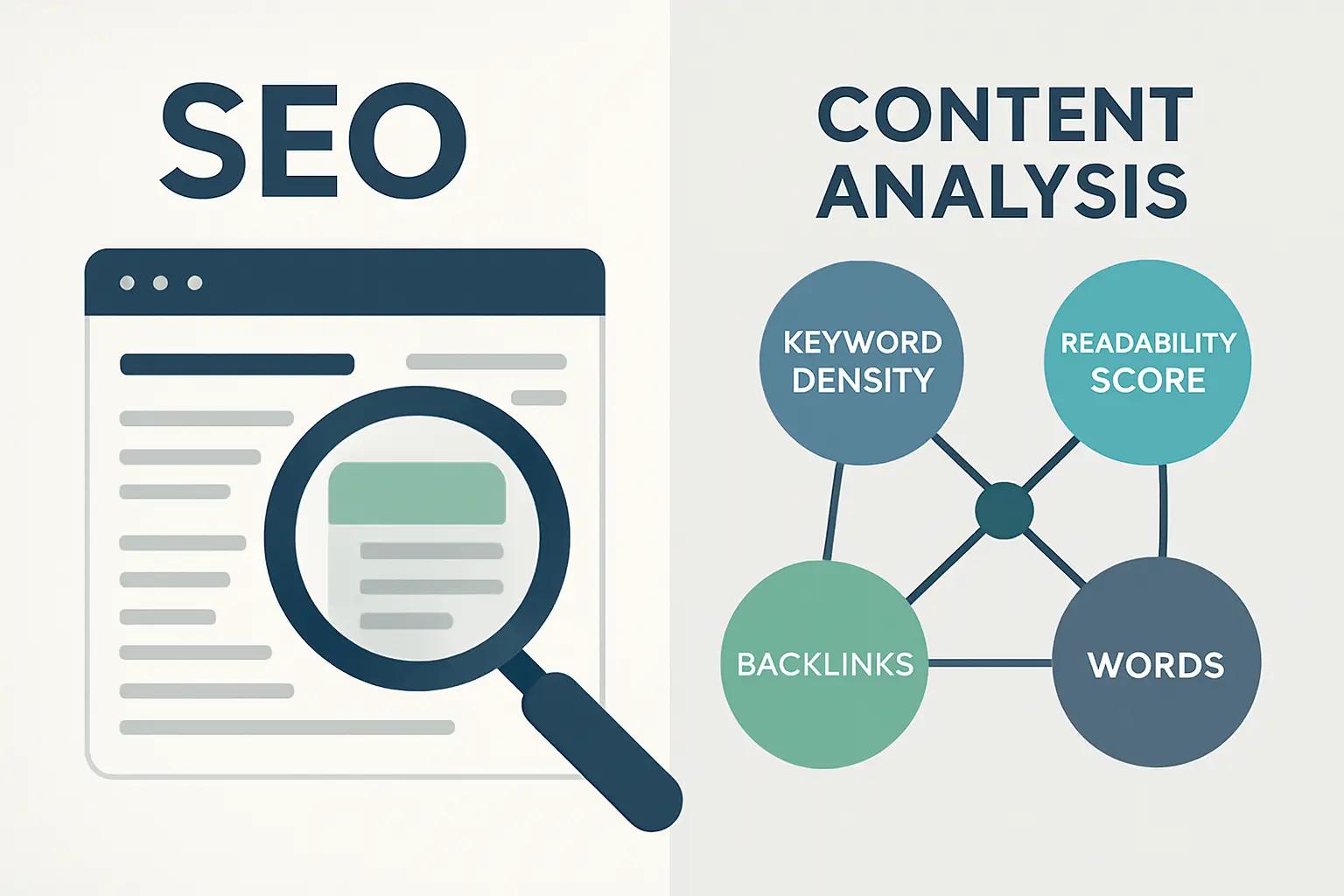Let’s face it: in 2025, relying purely on intuition to create content just won’t cut it. Data-informed content is quickly becoming the standard, and to stay competitive, you’ll need the right tools! Are you looking for the best content analysis tools for SEO in 2025? If so, you’re in the right spot. Think of these tools as your secret weapon, providing actionable insights that can boost your SEO performance and ensure your audience has a fantastic experience.
- SEO content analysis tools are becoming essential parts of modern SEO strategies.
- We’ve come a long way from simply stuffing keywords into content. Now, it’s all about creating high-quality content that your audience genuinely wants to read.
- AI and machine learning are playing an increasingly significant role, helping us understand content like never before.
- In this article, we’ll cover on-page SEO analyzers, competitor analysis tools, readability checkers, and even AI-powered writing assistants designed to improve content quality analysis.
- These tools help achieve goals like better rankings, more organic traffic, and ultimately, higher conversion rates. I mean, who wouldn’t want that?
Data Points & Statistics:
- Content marketing is booming! Studies consistently show a rise in its impact on lead generation year after year.
- The content analysis tool market is projected to hit new heights in 2025. Keep an eye out for updated market reports for specific figures.
- A significant percentage of marketers are already relying on data-driven insights to guide their content strategy.
Top Content Analysis Tools for SEO in 2025
Let’s jump into the best content analysis tools expected to be making waves in 2025. We’ll explore their features, benefits, pricing, and ideal use cases. If you’re actively looking for content optimization tools, you probably want practical, real-world advice. So, let’s get right down to it.
- Tool 1: Surfer SEO
- Surfer SEO’s core functionalities include keyword analysis, on-page optimization, competitor analysis, and even identifying latent semantic indexing (LSI) terms.
- Its unique strengths lie in its content score, NLP analysis, and the ability to generate truly comprehensive content outlines that give you a significant head start.
- Pricing options are tiered to meet different needs, offering different plans with varying features and usage limits.
- Ideal use cases include optimizing existing content, identifying content gaps, and improving readability analysis to keep your readers glued to the page.
- Pros: Data-driven insights to help create high-ranking content. Cons: The amount of data can be overwhelming for beginners.
- Example: Let’s say you’re writing about “best coffee beans.” Surfer SEO can help you pinpoint related terms people search for, such as “organic coffee beans” or “fair trade coffee beans,” allowing you to cover them in your article to create more comprehensive content.
- Tool 2: Semrush
- Semrush offers a suite of tools for keyword research, SEO audits, competitor analysis, and content optimization.
- Its features include an SEO Writing Assistant, robust topic research tools, and excellent competitor analysis capabilities – particularly helpful for uncovering LSI terms and broader key word strategies. For more options check the best content optimization tools.
- Semrush prices include various subscription plans tailored for different business sizes and needs.
- It’s a great tool for conducting in-depth keyword research, analyzing competitor strategies, and identifying trending topics.
- Pros: Comprehensive suite of tools, excellent for competitor analysis. Cons: The cost may be prohibitive for some very small businesses.
- Example: Imagine using Semrush to analyze a competitor’s article on “digital marketing trends.” You can see exactly which keywords they are targeting and identify any gaps that you could fill in your own content.
- Tool 3: Clearscope
- Clearscope emphasizes content optimization through keyword suggestions, competitor analysis, and real-time SEO analysis.
- A particular strength is its seamless integration with Google Docs, allowing you to optimize your content as you write it.
- Clearscope’s pricing is structured around content projects and the number of user seats.
- This tool is perfect for optimizing existing content, creating content briefs, and ensuring your content aligns perfectly with what’s already ranking on top pages.
- Pros: Excellent for content optimization, seamless integration with Google Docs. Cons: Functionality is fairly limited if you’re not using it for content optimization.
- Example: As you’re writing in Google Docs, Clearscope will provide suggestions for relevant keywords and other terms to include, which helps you create a well-optimized piece of content in real time.
- Tool 4: AIOSEO
- AIOSEO (All in One SEO) is a WordPress plugin that provides real-time SEO analysis, so you can optimize your website directly within WordPress.
- What sets it apart is its ease of use and smooth integration with WordPress, which makes it an appealing option for both beginners and seasoned SEO pros.
- AIOSEO has both free and premium versions, each with varying features and support levels.
- AIOSEO is perfect for on-page optimization, generating sitemaps, and generally improving your website’s overall SEO health.
- Pros: User-friendly interface, great for WordPress users. Cons: Limited to WordPress websites.
- Example: AIOSEO provides a score for your article right inside the WordPress editor, giving you direct feedback on how well optimized it is and suggesting improvements in real time. What’s more, you can always check content analysis tools for other options.
- Tool 5: MarketMuse
- MarketMuse uses AI to help with content planning, optimization, and competitor analysis.
- What’s unique is its AI-powered insights, which provide truly comprehensive content strategies.
- MarketMuse’s pricing is generally targeted to larger organizations with more complex content needs.
- It’s excellent for developing complex content strategies, identifying content gaps, and conducting competitor analysis at scale.
- Pros: Amazing AI-powered insights, comprehensive content strategies. Cons: The price may be a concern for some.
- Example: MarketMuse can analyze your entire website and identify content gaps that you should fill to truly establish authority in your niche.
- Consider checking out additional tools such as Frase, Scalenut, or ContentEdge to see if they’re a better fit. You can research other options using content analysis tools.
- One point for WordPress users: also explore dedicated WordPress SEO tools that offer real-time SEO analysis from directly inside your website’s backend.
Data Points & Statistics:
- Many of these tools share data on their websites regarding the SEO performance boosts users have experienced. Be sure and check them out!
- Look for awards or other forms of recognition that these tools have received.
- Read case studies and testimonials to see how users have increased rankings or boosted traffic using these tools.
- Whenever possible, try to find visuals: screenshots and examples that illustrate how the tools function in a real-world context.
- Comparison Table summarizing primary features. (Reference: SurferSEO blog.)
Selecting and Implementing Content Analysis Tools
Deciding which content analysis tool to use can feel overwhelming, but it doesn’t have to be! The trick is to find the tool that fits your specific needs and budget. Let’s walk through how to pick the right tool and how to implement it effectively so you can see a positive return on your investment (ROI).
- Budget: How much can you realistically afford to spend each month?
- Features: Which features are absolutely essential for you?
- Ease of Use: How easy is the tool to learn and use?
- Integration: How well does it integrate with the tools and workflows you’re already using?
- Team Size and Technical Skills: Is it a good fit for the size of your team? Also, consider the technical skills of your team!
- LSI Terms: Does it help you identify LSI terms effectively?
Here’s a step-by-step guide to implementing your chosen tools:
- Setting up accounts: Start by creating your accounts and configuring your settings to your specifications.
- Integrating with CMS: Connect the tool with your CMS (such as WordPress, for example).
- Training the team: Take the time to make sure your team members know how to use the tool effectively.
Keep a close watch on metrics like these:
- Keyword rankings
- Organic traffic
- Engagement metrics (bounce rate, time on page – very important!)
- Conversions (leads, sales)
- Continuously monitor your performance data and adjust your content and optimization strategy accordingly.
- Avoid common mistakes, such as over-optimization, ignoring user intent, and blinding following tool recommendations without considering the bigger picture.
Data Points & Statistics:
- Look for case studies of companies that have successfully implemented content analysis tools – they can be a great source of ideas and inspiration.
- Data shows a solid average ROI for marketers who incorporate content analysis tools into their work.
- Before you make a purchase, create a checklist of all the factors you need to consider. This will give you solid ground to stand on when making a final decision.
- Many companies see measurable improvements in their SEO results soon after adopting these tools, though your mileage may vary.
Future Trends in Content Analysis
So, what does the future hold for content analysis? The role of AI and data-driven insights is only going to increase. Here’s a quick look at what you can expect:
- AI and machine learning will continue to automate content analysis and optimization processes to an even greater degree.
- Predictive analytics may allow us to forecast content performance and identify emerging trends before they even take off.
- Personalization and a deeper understanding of user intent will be cornerstones of next-gen content analysis strategies.
- Voice search and other emerging technologies (like visual search, perhaps?) will continue to impact overall content optimization strategies.
- Keep an open mind and embrace new technologies! Staying adaptable is key to remaining competitive in content marketing. Take a broader view by checking the best SEO tools.
- As always, strike a balance between data-driven insights and your own creativity and expertise to create content that is both compelling and effective. Don’t let data smother your imagination.
Data Points & Statistics:
- The consensus among experts is that AI and machine learning will have a significant and growing impact on content analysis.
- Personalized content marketing is on the rise and isn’t expected to slow down any time soon!
- The adoption of voice search is growing rapidly, fundamentally changing the way people seek out information. By the way, it’s time to discover the content marketing analytics tools of tomorrow
- Ready to improve your content and boost your SEO performance? Start exploring content analysis tools today, and see what a positive impact they can have.

